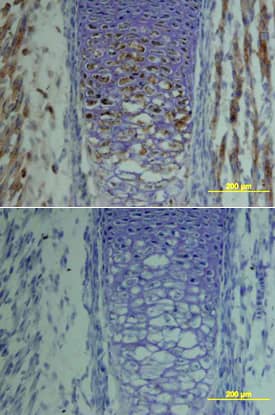Mouse TSG Antibody
R&D Systems, part of Bio-Techne | Catalog # AF756


Key Product Details
Species Reactivity
Validated:
Cited:
Applications
Validated:
Cited:
Label
Antibody Source
Product Specifications
Immunogen
Cys25-Phe222
Accession # Q9EP52
Specificity
Clonality
Host
Isotype
Scientific Data Images for Mouse TSG Antibody
TSG in Mouse Embryo.
TSG was detected in immersion fixed frozen sections of mouse embryo using 15 µg/mL Goat Anti-Mouse TSG Antigen Affinity-purified Polyclonal Antibody (Catalog # AF756) overnight at 4 °C. Tissue was stained (red) and counter-stained (green). View our protocol for Fluorescent IHC Staining of Frozen Tissue Sections.TSG in Mouse Embryo.
TSG was detected in immersion fixed frozen sections of mouse embryo using Goat Anti-Mouse TSG Antigen Affinity-purified Polyclonal Antibody (Catalog # AF756) at 15 µg/mL overnight at 4 °C. Tissue was stained using the Anti-Goat HRP-DAB Cell & Tissue Staining Kit (brown; Catalog # CTS008) and counterstained with hematoxylin (blue). Lower panel shows a lack of labeling if primary antibodies are omitted and tissue is stained only with secondary antibody followed by incubation with detection reagents. View our protocol for Chromogenic IHC Staining of Frozen Tissue Sections.Applications for Mouse TSG Antibody
Immunohistochemistry
Sample: Immersion fixed frozen sections of mouse embryo
Western Blot
Sample: Recombinant Mouse TSG (Catalog # 756-TG)
Formulation, Preparation, and Storage
Purification
Reconstitution
Formulation
Shipping
Stability & Storage
- 12 months from date of receipt, -20 to -70 °C as supplied.
- 1 month, 2 to 8 °C under sterile conditions after reconstitution.
- 6 months, -20 to -70 °C under sterile conditions after reconstitution.
Background: TSG
Twisted Gastrulation (TSG) is a secreted, cysteine-rich protein that plays a role in dorsal/ventral patterning by regulating BMP signaling in Drosophila and Xenopus. TSG was originally identified in Drosophila melanogaster and shown to be required for the differentiation of the dorsal amnioserosa cells. Vertebrate TSGs were subsequently cloned in mouse, human, zebrafish and frog. Mouse TSG encodes a 222 amino acid (aa) residue precursor protein with a 24 aa residue putative signal peptide that is cleaved to generate the 198 aa residue mature protein. Studies of expression and function of Twisted Gastrulation have been performed in Drosophila and Xenopus. Xenopus TSG is expressed in the ventral regions of the embryo during gastrulation, mimicking the BMP-4 expression pattern. dTSG is expressed in dorsal cells of the blastoderm embryo, where there are also high levels of activity of Dpp and Screw. In vivo, TSG acts as an agonist for BMP signaling by modulating the inhibitory actions of the BMP antagonist, Chordin/Sog and the cleavage properties of the metalloprotease, xolloid/tolloid. The N-terminal domain of TSG can bind BMP protein directly in vitro and shows BMP antagonist activity.
References
- Mason, et al. (1994) Genes Dev. 8:1489.
- Oelgeschlager, et al. (2000) Nature 405:757.
- Yu, et al. (2000) Development 127:2143.
- Dale (2000) Current Biology 10:R671.
Long Name
Alternate Names
Gene Symbol
UniProt
Additional TSG Products
Product Documents for Mouse TSG Antibody
Product Specific Notices for Mouse TSG Antibody
For research use only
